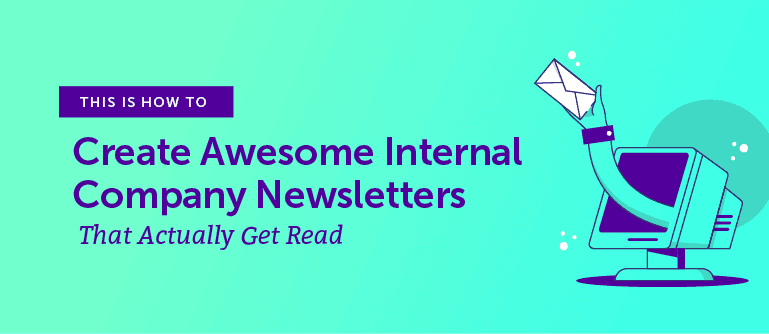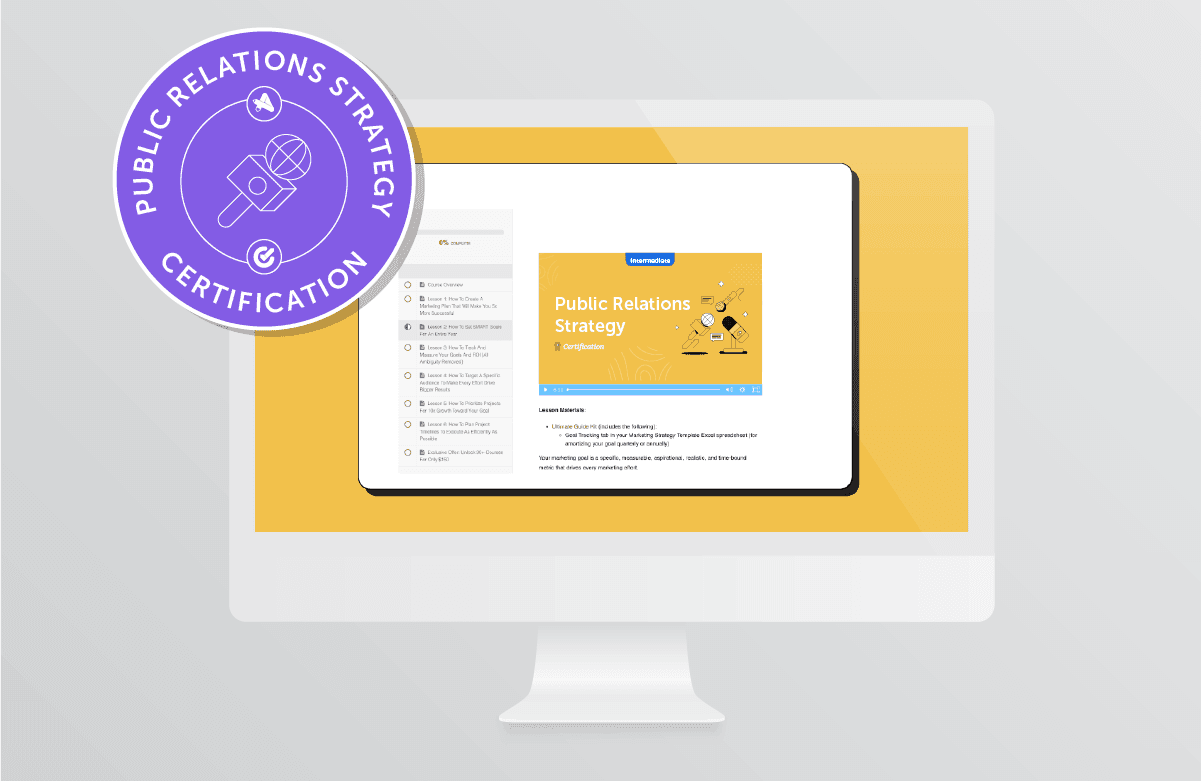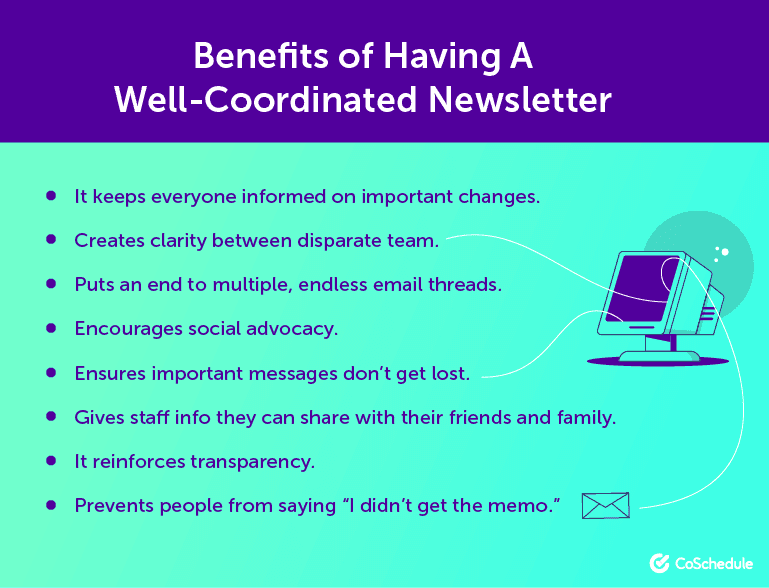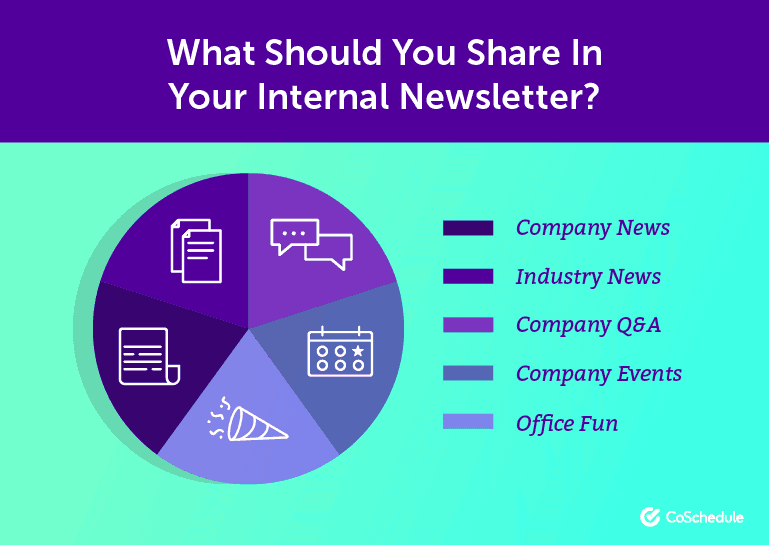How to Create Awesome Internal Company Newsletters That Actually Get Read
 Internal newsletters are important tools for keeping teams informed company-wide. This is especially true for larger organizations where teams may be in silos. Team members rely on these emails to know what's happening around the business.
However, making them engaging isn’t easy. People already spend too much time in their inbox. How can you convince them to read one more email?
It takes careful planning, consistent execution, and an understanding of what your coworkers want to read.
Fortunately, that's exactly what this post will cover (and more). This complete step-by-step guide will turn tired internal communications into invaluable insights that make an impact.
Internal newsletters are important tools for keeping teams informed company-wide. This is especially true for larger organizations where teams may be in silos. Team members rely on these emails to know what's happening around the business.
However, making them engaging isn’t easy. People already spend too much time in their inbox. How can you convince them to read one more email?
It takes careful planning, consistent execution, and an understanding of what your coworkers want to read.
Fortunately, that's exactly what this post will cover (and more). This complete step-by-step guide will turn tired internal communications into invaluable insights that make an impact.
Build Strategic Partnerships To Grow Your Brand
Your employees are just one audience that can help you promote your brand, products, & company. Tap into other key relationships with a strong PR Strategy. Enroll in Actionable Marketing Institute's Public Relations Strategy Certification course to unlock lessons, templates and video tutorials to create a successful PR strategy.
How to Create Awesome Internal Company Newsletters That Actually Get Read via @CoSchedule
Click To TweetWhat Exactly Is An Internal Newsletter?
It’s an email (or printed publication) that rounds up news, announcements, and other pertinent information that’s important for staff to know. This post will focus on creating and distributing them via email. Your company’s internal news emails don’t have to look much different than one you’d send to customers.Need newsletter examples to inspire your own? Find 'em here:
Click To TweetWhy Does My Company Need a Newsletter?
You might be wondering, “Shouldn’t I be spending my time marketing to customers instead?” If you’re a marketer, that sentiment is understandable. But, ignore internal communications at your own peril. There are tons of benefits behind having a well-coordinated newsletter. Here are several to consider:- Keeping everyone informed on important changes. No one likes feeling out of the loop.
- Creating clarity between disparate teams. Showing what different teams are accomplishing cultivates understanding between groups that don’t usually work together.
- Putting an end to multiple, endless email threads. Instead of news being sent out piecemeal through multiple email threads, you can just send one awesome email.
- Encouraging social advocacy. Including things coworkers can share on social makes it easier for them to become social advocates.
- Ensuring important messages don’t get lost. Tools like Slack and Hipchat are great, but it can be hit-or-miss whether your messages get seen there or not.
- Gives staff info they can share with their friends and family.
- Reinforces transparency. Sharing information helps show the company cares about being open and honest.
- Prevents people from saying “I didn’t get the memo.” If your newsletter becomes habit-forming, they’ll always be in the know.

Why should companies consider creating employee newsletters? Get the scoop here from @CoSchedule
Click To TweetGetting Started: Know Your Audience
An obvious answer to this is “the whole company.” But, depending on the size of your organization, this question may get a little more challenging to answer. For example, various departments could have news roundups pertinent to their area. If your company has tens of thousands of employees, allowing individual departments to create their own newsletters might make the most sense. Otherwise, company-wide is the best bet. Even if you know your coworkers well, it’s worth spending time getting to know each team. Here are some common departments your company might include:- Marketing
- Accounting
- HR
- Project Management
- IT
- Development
- Support
- C-Suite
How Can You Get to Know Your Coworkers Concerns?
Here are some ideas to get insight into what info teams want most:- Drop by people’s desks. If you can, just informally swing by and ask a few questions. Explain that you’re gathering research for a company newsletter.
- Schedule meetings. Block off 30 minutes each with coworkers on different teams to find out what kinds of questions they have about what’s happening in the company, and what they’d find useful to know.
- Send out a survey. Create a survey using Survey Monkey, Polldaddy, or Google Forms and share the link via chat app (such as Slack or HipChat) or company-wide email.
- What do you like (or dislike) about our current company newsletter (if you have one)?
- Which information is most important to you?
- Are there questions you have about the company?
- Do you wonder what other teams and departments are doing?
- How often would you like to receive updates?
 Then, give it a clear title:
Then, give it a clear title:
 Next, add each question, selecting the Short Answer option for each one:
Next, add each question, selecting the Short Answer option for each one:
 At this point, click Send. This will bring up the following screen (select the middle option to send this form as a link):
At this point, click Send. This will bring up the following screen (select the middle option to send this form as a link):
 Finally, drop the link into a company-wide email. Here’s some copy-and-paste text you can use:
Finally, drop the link into a company-wide email. Here’s some copy-and-paste text you can use:
Greetings, The marketing team is preparing a new internal email newsletter to keep everyone up-to-date on the latest happenings at [YOUR COMPANY]. To make it the best it can be, we’d like your feedback on what you’d like to see in the newsletter. It’ll only take a few moments to complete, and your responses will help us make sure it’s a useful resource company-wide. Thanks for your time! Let me know if you have questions. Best, [SIGNATURE]That should give you a good start on developing a newsletter content strategy.
Planning Your Newsletter Content: 20 Ideas Anyone Can Use
Now that you have an idea of what your internal audiences want, it’s time to put together a content plan. This entails determining the topics, content types, sections, and themes your newsletters might include. Here’s a list of ideas to get the wheels turning.
1. New Hire Announcements
Who’s that new face around the office? Let people know before they call security on a stranger in the building. Consider including:- Obvious stuff like name and job title.
- What they do at the company.
- Their interests and hobbies.
2. Company Achievements
Did your organization just smash a sales goal? Appear at a major industry conference? Land an awesome new customer? Let everyone know instead of assuming word of mouth will get around!3. Internal Policy Changes
No one wants to get caught breaking company policy because they didn’t know something changed. Say there’s a change to which doors are acceptable for staff to access your building. To make sure no one uses an incorrect entrance, let them know which ones they can (and can’t) use, and why.4. Revenue Updates
People like to know their jobs are secure. They also need to know when things aren’t going so well, too. Consider including monthly or quarterly revenue numbers, so everyone knows where the company stands.5. Event Announcements
From potlucks to trade show appearances, let people know what’s coming up. That could include:- Event dates. Toss those on your company’s internal calendar, too.
- How staff should dress. No one wants to look out of place.
- Do they need to bring anything? Avoid potlucks where you have 12 bags and chips and nothing else.
6. Show Off What Teams Are Working On
People throughout your company are probably working on cool stuff they’re passionate about. People on other teams might have no idea what those things are. So, ask around and see what’s cooking that’s worth sharing. These don’t necessarily need to be groundbreaking innovations, either. Maybe accounting found a way to better notify staff when their paychecks are deposited. Or, the dev team could have gotten your site to load faster. Maybe you could even share a walk-through of basic things different teams are responsible for.7. Highlighting Employee Accomplishments
Recognize achievement! This could include:- Promotions. Who’s getting a new title?
- Speaking engagements. Did you have a team member speak at an event or conference?
- Crushing their goals. Let people know their hard work is appreciated.
“By now, it’s a well-known fact that employees aren’t feeling valued at work. And honestly, there really is no such thing as “too much recognition.” If you really want to keep your employees, motivate them through recognition. That simple validation has the power to drive productivity through the roof.”The data bears that out, too. According to a study from Pyschometrics, 58% of employees said recognition was the number one thing leadership could do to make them feel more engaged.
 Source
When asked what leaders could do more of to improve engagement, 58% of respondents replied “give recognition”
Source
When asked what leaders could do more of to improve engagement, 58% of respondents replied “give recognition”
8. Awards
Did your company win an industry award, get placed on the Inc. 5000, or something similar? Let everyone know what the award is all about, why it’s important, and how it’ll help raise the company’s authority and visibility.9. Interesting Industry Articles
Build a list of relevant news sources for industry, follow them all using an RSS reader like Feedly, and share the best stuff that’ll help coworkers be more informed and do their jobs better.
10. Your Latest Blog Posts
If there’s content on your blog that’d be interesting to your coworkers (and not just your consumer audience), think about dropping a couple into your newsletter.11. New Feature or Product Announcements
Launching new features or products can potentially have a broad impact across your business. Marketing teams will need to know something’s coming up for them to sell. Customer support teams might need to be prepared to answer questions. Make sure that information is in your newsletter.12. Notes From Your Leadership Team
Engaged employees like feeling as though they have a direct line of communication with leadership. Having your CEO or a department lead include a note or a letter shows they want to be involved in connecting with the company and transparently sharing important info. Source
Source
13. Upcoming Holidays and Days Off
Save your HR department some questions and let people know when not to show up.14. Day-in-the-Life Stories
So, what exactly does [NAME] over in [DEPARTMENT] actually do all day? Set up an interview time to ask questions, shadow them with a camera, and share their story in the newsletter. Here’s an example from Microsoft highlighting one of their employees:15. Customer Success Stories
How is your company helping customers? Find a customer story and write about it. Some good places to find quality candidates might be your customer support or PR teams. Here’s an example from CoSchedule’s own internal marketing newsletter:
16. Company News Coverage
Did you land some nice media coverage? Odds are, your coworkers would like to know. You might want to stick to positive coverage for your purposes here, though.17. How-To Blog Posts
Find something interesting that will help people in your company do their work better? Include it! Here are some ideas:- General office productivity tips.
- Info on staying healthy at work.
- Guides on performing certain tasks.
18. Fun Moments from Around the Office
Of course, be careful not to embarrass anyone against their own wishes. But if there’s something fun or goofy happening, snap a photo and tell a short story to go along with it. Here’s an example of a gag CoSchedule’s Bismarck office set up in a street-facing front window display:19. Employee Questions-and-Answers
If you business does anything at all, someone is guaranteed to have a question. Leave a section somewhere asking employees to submit any questions they have, and then choose a few to answer in the next edition of the newsletter. Sometimes, people have good questions, but don’t ask them because they’re never prompted. Include something like this:We believe great questions can come from anyone, anywhere. Have something you’d like to know? Send your questions to [INSERT OF POINT OF CONTACT] and you might see an answer in the next edition of [NAME OF NEWSLETTER].
20. Community Event Announcements
Are there any cool things happening in the area around your office that might make good team-building events (re: an excuse to get to know coworkers outside of work)? Include one or two. People might appreciate the heads up and check things out they would have otherwise missed, while getting to know the people they work with everyday. One way to find events is to check out local publications and city magazines in your area. For example, Fargo Monthly (a city magazine) hosts an event calendar with upcoming things to do in town:
Next, Nail Down Your Newsletter Content Strategy
So, that’s plenty of ideas to get you thinking. At some point though, you’ll need to determine what types of content you’ll include in each newsletter. Keeping it consistent makes it easier to gather and write what you need, rather than wondering what to include. If you need a starting point, here’s a recommended mix:- 5 pieces of company-related news.
- 3 pieces of content from around the web.
- 1 “fun” piece.
- An upcoming company events calendar.
- Call-to-action soliciting questions from around the company.
 Putting some constraints on content selection will force you to select only the best and most relevant stuff to share. Feel free to mix up your formula (and even disregard these suggestions completely—do what works best for your situation).
Putting some constraints on content selection will force you to select only the best and most relevant stuff to share. Feel free to mix up your formula (and even disregard these suggestions completely—do what works best for your situation).
4 Newsletter Best Practices to Follow
Internal communications are different from consumer-facing communications in a lot of ways. If you’re new to creating content for internal comms, you might have some questions on what makes sense to share, and which things might be off limits.1. Use Humor Sparingly
Not everyone is a comedian, and it’s easy for jokes to come off unintentionally insulting. If you’re going to share a joke at a coworker’s expense, make sure you get their permission first, and use your best judgment in determining whether its workplace-appropriate.2. Keep It Concise
People don’t have time to read 10,000-word articles on work time. Get to the point.3. Be Truthful
Encouraging transparency is a major benefit for creating a newsletter in the first place. If it isn’t truthful, or if its used to mask company failings, then the trust transparency builds can be lost quickly. Don’t lie, obfuscate facts, or otherwise try to spin negatives into positives in ways that are dishonest.4. Prioritize Important Information First
It might be tempting to load up on fun content, especially if you have a free-spirited company culture. But, that kind of stuff usually isn’t the best at supporting a newsletter’s core purpose. Consider using a 90/10 split between serious or professional content, and mix in a little bit of fun to keep it from being too dry.How to Write the Best Newsletter Possible
Now you’re finally ready to start writing some content.Give it a Name
A good name helps your newsletter be more recognizable. Try to create something more interesting than “the company newsletter,” or something generic.Establish Tone and Voice
Speaking of generic, an email that sounds cold and corporate isn’t going to get read, because it’s going to be boring. You might already understand tone and voice. But, even if you have each dialed in for your customer-facing content, you might need to rethink it for your internal communications. So, here’s a summary:- Voice: This is what you sound like all the time.
- Tone: This is the inflection you apply to your voice.
Writing Headlines
Now, each section will likely have a headline or sub-headline. If you want to really give each one some polish, use the Headline Analyzer Studio. The public version is always free to use, and it’s also built directly into CoSchedule:
Get the Subject Line Right
Boring subject lines aren’t going to get read. So, there’s a simple solution: don’t write boring subject lines! Rather than reusing the same subject line each time, make them unique and get people excited to get the latest company news. One way to optimize subject lines is with the Email Subject Line Tester. Enter a subject line: Then, get a full analysis of what works, what doesn’t, and how to improve:
Then, get a full analysis of what works, what doesn’t, and how to improve:
 Like the Headline Analyzer Studio, the web version is free, and it’s also built directly into CoSchedule. Test some subject lines here.
Like the Headline Analyzer Studio, the web version is free, and it’s also built directly into CoSchedule. Test some subject lines here.
Drafting Articles
Readers will most likely skim your email. So, stick to standard web writing best practices:- Keep sentences 20-25 words or less.
- Keep paragraphs at three sentences or fewer.
Designing Your Newsletter
Your email design should be consistent week-to-week (unless you’re testing design elements, or have a reason to strategically change a variable).Visual Design vs. Plain Text
Studies showrecipients prefer plain text emails. But, like many things, that information needs to be taken with a small grain of salt (plain text is great, but there’s still a place for designed HTML emails, too). For your purposes here, a designed email will likely be more visually interesting and hook coworker’s attention. Test both and let data drive your decisions moving forward, though.Choosing a Template
If you have a designer or developer who can build you a template, you might choose to skip this section. However, if you don’t have access to someone who can build an email template for you, there are tons available on the web you can customize and use for free.Setting Your Distribution Frequency
There’s no right or wrong distribution frequency. But, you might want to start with a weekly or monthly schedule. You can also use a survey to ask your organization how often everyone would like an email update.Planning Email on Your Marketing Calendar
If you’re using an internal communications calendar, use it map out your newsletter sends. That way, it won’t get forgotten, and you can ensure consistent delivery. You’ve got two options here:- Use the free template included in this post. It’s Excel-based and makes it simple to plan email sends.
- Use an app (like CoSchedule). As an all-in-one marketing management platform with robust email integrations (with MailChimp, Campaign Monitor, ActiveCampaign, and Constant Contact), you can plan and schedule every email send, giving your entire team full visibility.

Measuring Impact
How can you know whether your newsletter is actually useful? Most email service providers have powerful analytics features built in that make it easy to track performance. Take a look at the following:- Open rates: Indicates how many people were compelled by your subject line.
- Click-through rates: Can help determine whether people were interested in the links the email included. This measures the percentage of recipients who click a link.
- Click-to-open rates: Similar to click-through rate, but it calculates the total number of unique link clicks, relative to the number of unique opens.
Getting Feedback
Listen to direct feedback from recipients. Once you’ve been sending these emails for a while, send out a survey asking what people think. Include questions like:- How often would you like to get these updates?
- Is there any information that’s not useful?
- Is there anything you’d like to see added?
- Do you have other thoughts you’d like to share?
A Simple Newsletter Creation Workflow Checklist
Checklists make managing any workflow easier, and your newsletter creation process is no exception. Follow this simple checklist to make creating each one more efficient:- [ ] Establish theme.
- [ ] Generate content topics.
- [ ] Gather curated content to include.
- [ ] Write subject line and subheads.
- [ ] Craft newsletter copy.
- [ ] Design graphics.
- [ ] Place content into template.
- [ ] Proofread.
- [ ] Schedule email delivery.
- [ ] Review analytics.

Managing Everything With CoSchedule
Not only can you build checklists to manage your workflow, you can manage your entire newsletter creation process in CoSchedule, thanks to key integrations with MailChimp, Campaign Monitor, Active Campaign, and Constant Contact. CoSchedule, as you might know, is a calendar-based marketing management platform. It’s your homebase where every project and campaign starts, including emails. First, connect your email service provider. Then, select a day on your calendar, and choose Email Marketing: Give the newsletter a title and select MailChimp to create the email (for other email service providers, the email will need to be created in your ESP first, and will then appear on the CoSchedule calendar):
Give the newsletter a title and select MailChimp to create the email (for other email service providers, the email will need to be created in your ESP first, and will then appear on the CoSchedule calendar):
 Next, write your subject line and get real-time analysis to improve it:
Next, write your subject line and get real-time analysis to improve it:
 As you create your newsletter content, follow the steps in your task template, and collaborate with other team members (like designers and project managers) using Discussion Threads:
As you create your newsletter content, follow the steps in your task template, and collaborate with other team members (like designers and project managers) using Discussion Threads:
 That’s just a quick look inside CoSchedule. To see how it all works together, schedule a demo with an expert, or get started free. It’s the best way to keep your entire marketing department organized.
That’s just a quick look inside CoSchedule. To see how it all works together, schedule a demo with an expert, or get started free. It’s the best way to keep your entire marketing department organized.
Now Continue To Grow Your Team Of Brand Advocates
Your internal company newsletter is a great way to empower your employees to promote what your company is doing. Now it’s time to tap into other audiences that can help you expand your reach to potential new customers. AMI’s Public Relations Strategy Certification course will help you nail down the best partnerships you should consider & how to develop beneficial relationships. You’ll also get 12 video tutorials & 12 premium templates to develop an entire PR strategy from start to finish.
Take the initiative, get certified!
You’ll also get 12 video tutorials & 12 premium templates to develop an entire PR strategy from start to finish.
Take the initiative, get certified! 

